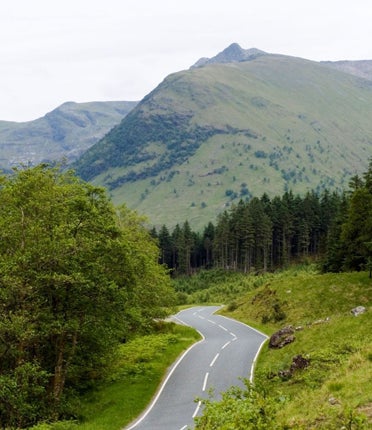A guide to A-road Britain: A82
Richard Wilson takes the high road from Glasgow to Fort William and the foothills of Ben Nevis. Scotland's great contrasts are here, from busy city streets to the empty beauty of Glencoe

There is grandeur of every kind as the A82 carries you from almost the centre of Glasgow to Fort William in the foothills of Ben Nevis.
No road perhaps better contrasts the tendencies of man and nature to create a sense of splendour, or even wonder. But then it is a feeling of separateness, a kind of detachment, that is emphasised as the landscape develops into something hostile yet beautiful.
At the beginning, beyond the accumulation of shops and commonplace bustle, the road skirts along the edges of the Botanic Gardens, where people are lazily scattered in the brightness of the afternoon sun, and past rows of Alexander "Greek" Thomson terraced houses. The buildings stand, on each side, behind a fringe of trees, creating the effect of a boulevard, and are haughty with an ageing elegance. Yet there is sadness, too, in the way some have become dark with smog, or poorly maintained, their architectural glory now faded and melancholic.
Once the city and a periphery of suburbs is left behind, the countryside comes upon you in a rush, as if the urban grit has to be sloughed off urgently. Then it is a short drive, no more than 30 minutes, before you are upon the banks of Loch Lomond, where the light catches the water in glinting sparkles and the serenity is broken only by glimpses of boats ambling across the vast expanse of water.
Already, Glasgow, a city hardened by its industrial heritage of shipbuilding, tenements and working-class frankness, is a memory, and this is one of the journey's treasures, the way one life can be so abruptly supplanted by another. Here the road is hemmed by folds of green fields on one side, and water on the other as it follows the perimeter of the loch with dutiful care. Even the turns – sometimes casual, sometimes sharp – fall into a rhythm.
At times the road tightens, and runs so close to sheer banks of rock that you feel belittled. Some stretches are accused of being treacherous, and there is often not enough room for a car and coach to pass. The sense, as giant trees on both sides create dim tunnels, is of being overwhelmed.
You emerge into a climb up Glen Falloch towards Crianlarich, and the horizon suddenly widens, as if gasping for breath. After passing through Tyndrum, where walkers on the West Highland Way often stop for recuperation, the landscape turns stark. The valleys are barren but for clutches of gorse, while glacial mountains veer forbiddingly into the cloud-strewn sky. The peaks are tipped with snow and they appear stern, as if disdainful of all but their own hefty presence.
This is the Highlands, and vantage points are encountered at various intervals along the side of the road. Occasionally a piper is found at these stopping places, and it is worth parking to stretch your legs while taking in the great weight of the scenery, and the growing realisation that the road is a thin, almost insignificant feature across the terrain.
Once back in the car, the journey carries on to Rannoch Moor, and even more desolate glory, before Glencoe. The beauty is forbidding, a grave austerity. The outlines of solitary buildings can occasionally be seen in the distance – Sir Jimmy Savile is said to still own a home in these remote tracts of land – while the mountains seem to sadly recall the history of the Massacre of Glencoe and the legend of cattle rustling between rival clans. Everything seems diminished here by the sharp peaks that pierce the clouds scuttling around them. Walkers and skiers are drawn to these slopes and passing through them by car seems an act of haste. But then the road delivers you to the wide, almost optimistic, spread of Loch Leven.
After a climb through rocky outcrops, you drive over the stately Ballachulish Bridge. You feel open again, as if released, and people suddenly come upon you, in the roadside villages or even just in a greater concentration of traffic, as though you've emerged from something solitary and distant. Following the edge of the water, the road carries on to the lower reaches of Ben Nevis, then beyond to Loch Ness then Inverness. But nowhere on this route is more arresting than the stage from Glasgow to Fort William – a journey of divergences.
Join our commenting forum
Join thought-provoking conversations, follow other Independent readers and see their replies
Comments